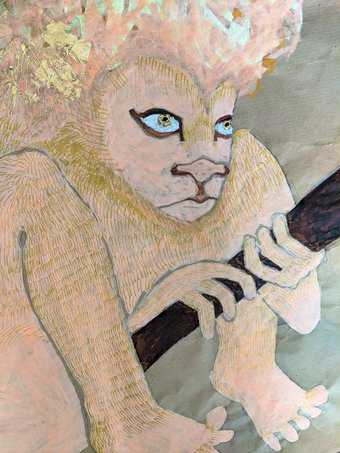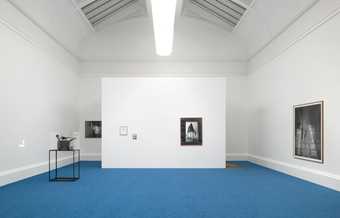
© Matt Greenwood
France-Lise McGurn's Sleepless explores the intimacy of city life. It invites audiences to form their own understandings of the work, as the paint spills across the canvas onto the walls, floors and ceilings.

Installation views, Art Now: France-Lise McGurn Sleepless, 2019. Photo ©Tate - Oliver Cowling
Could you tell me about the inspiration behind the title Sleepless?
I wanted to give the work a title that would be quite broad, because I was going to have to do so much of the work when I arrived at the gallery. Effectively, I'm titling it before I've even made it. Because I work so quickly and so much on-site, I wanted to choose something that I could use as a bracket term that wouldn't narrow it down too much.
Sleepless was a title that I felt would give the work a feeling, rather than a narrative. Because a lot of the work I have made up until this point has looked at nightlife and club life, I was thinking about Sleepless in that respect. I'm also a new mother, so I was also sleep-deprived when I was making the work.
I wanted to tap into an idea about consciousness and unconsciousness and how you can be awake or sleep-walking. I also really liked that I was referring to Sleepless in Seattle, a film I love because I've got a big thing about nostalgic popular culture and romantic comedies. In Sleepless in Seattle, the word 'sleepless' is actually a stand-in for a character’s name.

Installation views, Art Now: France-Lise McGurn Sleepless, 2019. Photo ©Tate - Oliver Cowling
You grew up in Glasgow. How much has that city influenced your work?
Last year, I was really lucky to be part of a show that was at Tate St Ives, which was about the writings of Virginia Woolf. That show then travelled and because I was the only artist that did something on the wall, I travelled with the show as well. I made three different pieces.
I really got to see this part of England that related to her writing. It made me rethink the archetype of Glasgow and the way that people think of Glasgow as part of this 'Grim Up North' place. I also got to think about how metropolitan and urban my work is and how much it relates to the city and being in quite a populated place. I was thinking a lot about that and also how Glaswegians have quite a strong identity and humour. I think that that definitely feeds into my work.
Relating to that travel through England and Virginia Woolf, I was thinking about Glasgow and how my dad used to work in town planning. He gave this talk, last year, where he spoke about the levels of lead in Glasgow’s water and how that had massively contributed to the levels of violence because of the way it had affected people. I was thinking about how living in close quarters is intimate, but almost in a violent way.
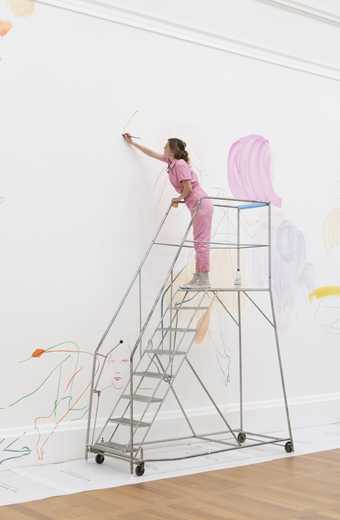
Installation views, Art Now: France-Lise McGurn Sleepless, 2019. Photo ©Tate - Oliver Cowling
What aspects of intimacy in city life are you interested in?
Because I work with figures, I looked at congregations of people, like parties, and thought about the subjects in those terms. For this show particularly, I was thinking about city life. The title Sleepless ties in with this because I was thinking about when I was lying awake at one point and I could hear my neighbour, in the middle of the night, moving under their covers. It made me think like how you're only two-feet (the size of the wall) away from people in the next flat, and they're naked, and you're doing your most intimate things, and how we actually live on top of each other.
How do those ideas relate to London or other big cities?
I lived in London when I studied. No other city I have lived in is quite like it. In London, you're living in a house that's been divided up 1,000 times and you’re actually living so intimately with other people. That was a massive thing I was thinking about, in terms of the way that the figures overlap and the paintings overlap with the wall paintings.
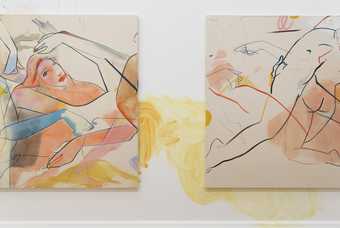
Installation views, Art Now: France-Lise McGurn Sleepless, 2019. Photo ©Tate - Oliver Cowling
How do you find your ideas and how you bring them into fruition?
I have a massive collection of found materials that feed into my work in a very indirect way. The majority, at the moment, are magazines. They are rarely from contemporary sources, purely because when something is from the past, the original intent of it is gone. It just becomes material and it becomes a way of psychologically looking at the past and thinking about where we are now. I look at a lot of old magazines like Jackie Magazine and others like it.
A lot of the times, a lot of the materials I look at are things that have been designed to be disseminated and then discarded. Like flyers, posters, magazines - anything printed. When I've collected these, I loosely draw on paper, draw at home, draw in the studio based on the themes. Then, I'll find that certain motifs will come out of that, and that will become a repeated motif in the rest of the work, so that when I get into the space, I have this bank of gestures, shapes and forms that I can pull out, really quickly, without having to step through a pile of stuff because I want the figures to be really familiar. I feel like I know the figures I draw and know what year they're from or where they're from. It’s not an exact appropriation, but the figures are based on what I’ve seen.
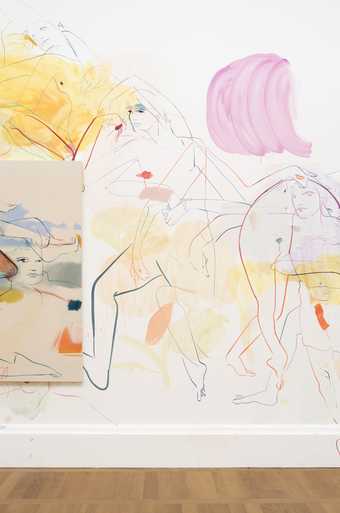
Installation views, Art Now: France-Lise McGurn Sleepless, 2019. Photo ©Tate - Oliver Cowling
How does it feel to paint on the walls outside of the canvas structure?
It feels really necessary to me. I only started working on canvas relatively late. I drew and I painted for a long time before I started working on canvas. I used to do huge collages on paper that covered the walls and then I made the really obvious jump to just work directly on the walls.
Of course, it means that it’s going to get rubbed out and then, something else is going to be there. But when it exists in the space, it’s animated and alive. That it's not there forever, is quite an important part of it. The wall seems like a really natural way to let the canvases fill out, so that they're not too contained.
When you're in a club environment, for example, as opposed to a gig, you know that something is happening around you, but you don’t know who the people are. It’s similar in my work. It's not that the portraits or the figures are an exact person, but that they have a presence and that all of them make a whole. The walls seem like a natural place to explore this.
I also think it has a lot to do with the way I was raised. My mum was an artist and she turned our house into a complete artwork. She would paint on the walls, on the carpets, on the floors, everything. It's about whatever is to hand. I think if there was an armchair and a three-piece suite in the gallery, I would paint on that as well.
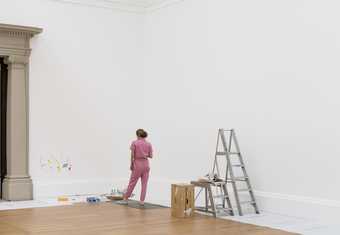
Installation views, Art Now: France-Lise McGurn Sleepless, 2019. Photo ©Tate - Oliver Cowling
What do you paint first – the walls or the canvases?
In this case, I painted the canvases in the studio first. I brought canvases from the studio, which has been quite an exciting thing for me because I've done a few works on the wall alongside significant paintings, but they've not been mine. My work has been the wall piece and then, other people have brought works into the space, but this has been really the first chance I've had in a while to put the two together and to work on a larger scale. To me, there's all these forms and shapes, and they're spilling out onto the canvas or onto the floor or onto the wall in an equal way.
Is there anything you want audiences to come away from when they leave the space?
I want the gallery space to be full of energy, and I think as long as people feel that and get some life from it, then that's okay. I don't know that I would ever want to be didactical or pre-prescribe a narrative for anyone. Something can be familiar, but also energetic. I wouldn't want to force anyone to feel anything different than that. It’s like any good work. As an artist, you would want it to offer more than that, but you cannot control that part.
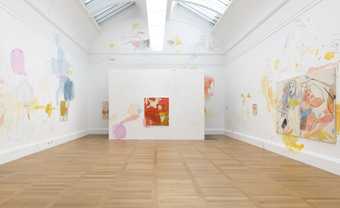
Installation views, Art Now: France-Lise McGurn Sleepless, 2019. Photo ©Tate - Oliver Cowling
Are there any artists that have inspired you?
I always feel a bit difficult about this question, because my work draws on quite a big history of figurative painting. I am a bit reluctant to situate it, because I think what happens with my work, sometimes, is people say, ‘Oh, it's like Picasso, it's like Matisse or a little bit Jean Cocteau’. It's probably all of those things. I do use these quite recognisable forms of how figures are made, but if I say who I'm directly inspired by, it situates my work in a place I don't really want it to.
Art Now: France-Lise McGurn: Sleepless is at Tate Britain until 8 September 2019.

